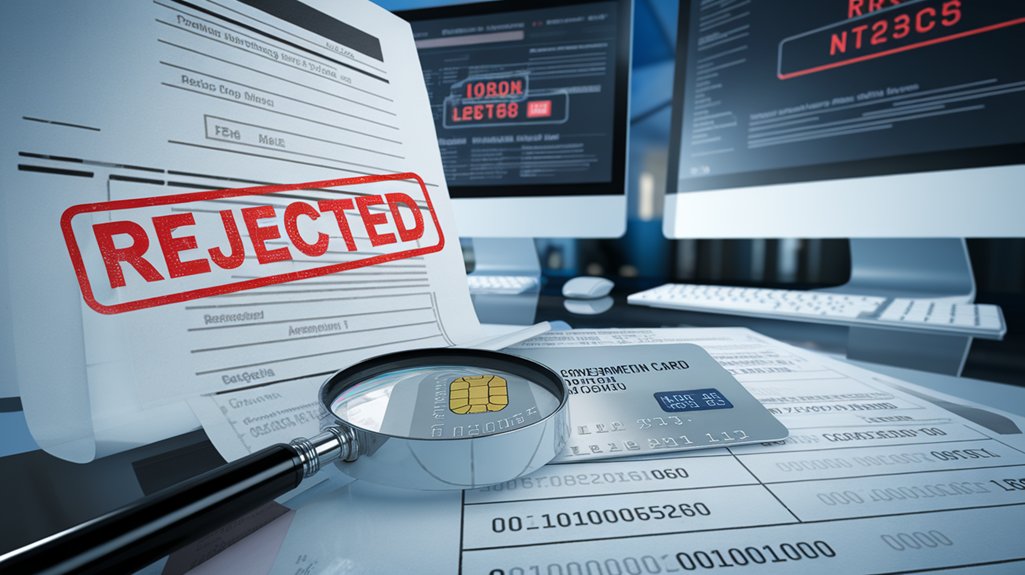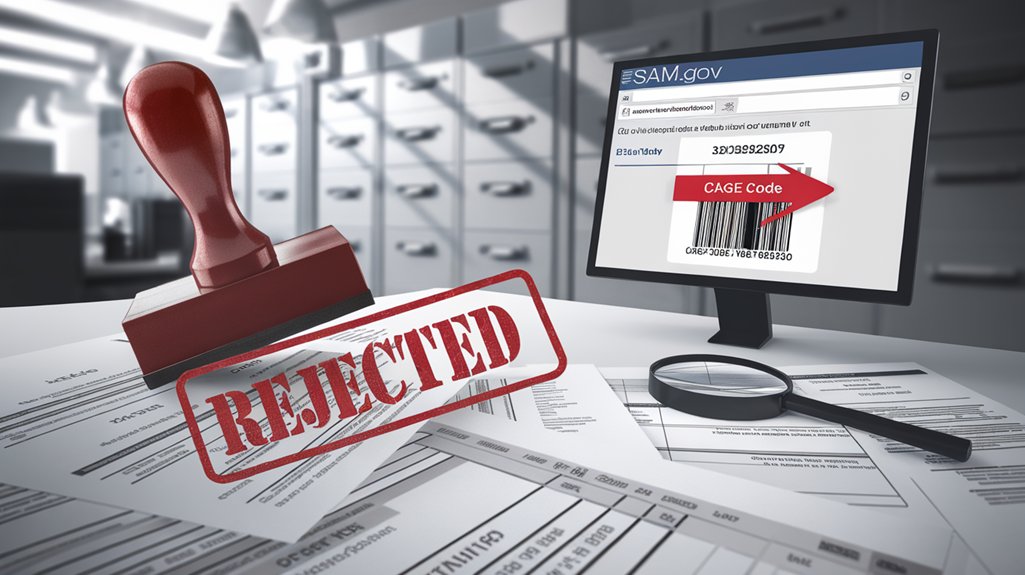SAM often rejects CAGE code applications due to address validation issues, including PO boxes, virtual mailboxes, or minor address discrepancies. Mismatched business data, such as name variations between SAM registration and state filings, incorrect EIN/TIN numbers, or entity classification conflicts also trigger rejections. To resolve these issues, businesses should contact the DLA CAGE Code office immediately, guarantee alignment between SAM.gov data and IRS records, and conduct quarterly reviews to maintain accurate information. Further exploration reveals preventative measures to avoid future validation problems.
Common Address Validation Issues That Trigger CAGE Code Rejections

When applying for a CAGE Code through the System for Award Management (SAM), address validation represents one of the most critical hurdles that businesses must overcome. The rejection reasons often stem from specific address verification issues that companies fail to anticipate.
PO boxes and virtual mailboxes are automatically rejected in the SAM system, with no exceptions granted even with supporting documentation. Similarly, commercial mail receiving agencies (CMRAs) and temporary co-working spaces frequently trigger rejections due to insufficient proof of physical operations. These verification steps are essential components of the federal procurement process that help maintain the integrity of government contracting systems.
Address discrepancies cause numerous validation failures, including minor differences like “St” versus “Street” or missing suite numbers between SAM profiles and supporting documents. Rigorous cross-referencing with government databases often reveals inconsistencies between records that applicants overlooked.
Home-based businesses face additional scrutiny, requiring proof of commercial zoning compliance. The physical address must consistently reflect where business is conducted and align with all official documentation submitted during the application process. Technical issues, such as geocoding mismatches and outdated mapping data in SAM databases, further complicate the verification process.
How Mismatched Business Data Affects Your CAGE Code Application

While many businesses focus solely on address validation, mismatched business data represents an equally critical factor in CAGE Code rejections. The Defense Logistics Agency‘s verification system cross-references multiple government databases, flagging inconsistencies that prevent successful registration.
Business name discrepancies and tax identification mismatches consistently rank among the top reasons for application failures.
Common data inconsistencies that trigger rejections include:
- Legal name variations between SAM registration and state business filings (e.g., “LLC” vs. “Inc.”)
- EIN/TIN numbers that don’t match IRS records exactly
- Unregistered “Doing Business As” names used in SAM profiles
- Entity classification conflicts (sole proprietorship vs. corporation)
- Socioeconomic status certifications lacking proper documentation
Companies must guarantee perfect alignment between their SAM registration, state business filings, and IRS records.
Even minor variations in business naming conventions can delay the CAGE code issuance process by weeks.
CAGE codes are strictly assigned only to physical addresses and not to temporary virtual locations or mailing addresses.
Regular profile reviews are essential to prevent your organization from being disqualified due to outdated information that doesn’t match current business records.
Businesses seeking assistance with CAGE code issues can contact the DLA Customer Interaction Center via email or phone for official guidance on resolving discrepancies.
Effective Steps to Resolve and Prevent CAGE Code Validation Problems

Resolving CAGE Code validation problems requires systematic troubleshooting and proactive management of business information across multiple government databases. When facing rejection, organizations should immediately contact the DLA CAGE Code office to identify specific validation issues and determine necessary corrections.
Effective validation strategies include ensuring complete alignment between SAM.gov data and IRS records, particularly regarding legal business names and taxpayer identification numbers. Organizations should establish documentation best practices by maintaining accurate records of all business information and promptly responding to any validation queries from government entities. Utilizing the search functions available in SAM.gov can help verify the accuracy of your CAGE code information before submission.
Prevention measures include:
- Conducting quarterly reviews of registered information
- Addressing any discrepancies between physical and mailing addresses
- Implementing standardized data entry protocols for all government registrations
- Utilizing PTAC resources for registration guidance
These proactive steps greatly reduce validation failures and minimize procurement delays, allowing businesses to maintain continuous eligibility for government contracts. Remember that CAGE validation failures are typically communicated via email, with specific contact information provided for timely resolution of any issues.
Frequently Asked Questions
How Long Does CAGE Code Validation Typically Take?
The CAGE code validation process typically takes 3-15 business days to complete.
This timeframe is integrated with the SAM registration system, where CAGE codes are automatically assigned to domestic entities. Processing time varies based on several factors, including information accuracy, entity type, and whether it’s a new assignment or renewal.
International entities requiring NCAGE codes may experience different timelines. Completing documentation properly and monitoring the CAGE homepage for system updates can help prevent delays.
Can Foreign Businesses Obtain CAGE Codes Through SAM Registration?
Foreign businesses cannot obtain standard CAGE codes through SAM registration.
International registration requires foreign entities to first secure an NCAGE (NATO Commercial and Government Entity) code before beginning the SAM process.
Foreign eligibility for government contracts depends on having this NCAGE code, which must be obtained through NATO’s Public CAGE portal.
The NCAGE code serves the same function as a CAGE code but is specifically designated for non-U.S. entities.
Are CAGE Codes Transferable During Mergers or Acquisitions?
CAGE code transferability during mergers and acquisitions exists but requires formal processing. Codes aren’t automatically transferred when companies combine.
The process requires:
- Completed novation agreements
- Legal documentation proving ownership transfer
- Formal request to Defense Logistics Agency
The surviving entity typically retains its original CAGE code, while the dissolved entity’s code becomes deactivated.
Different scenarios apply based on the specific merger structure, with separate codes maintained only for distinct physical locations.
How Often Must CAGE Codes Be Renewed or Revalidated?
CAGE codes themselves don’t have separate expiration dates but are directly tied to SAM registration maintenance.
The SAM registration, including the associated CAGE code, requires annual revalidation every 365 days to remain active.
Proper CAGE code maintenance involves verifying its accuracy during each SAM renewal.
If a SAM registration remains inactive for over five years, the CAGE code will expire.
Companies should begin the renewal process several months before expiration to prevent any lapses in registration status.
Can Multiple CAGE Codes Be Assigned to One Business Entity?
Yes, multiple CAGE code assignments can be issued to a single business entity, but only under specific conditions.
A business may receive separate CAGE codes when it operates at distinct physical locations with unique addresses. Each location requires its own documentation, including Tax ID verification and address proof.
Different business entity types, such as subsidiaries or divisions, may qualify for separate CAGE codes if they function at different geographic locations with distinct operational purposes.